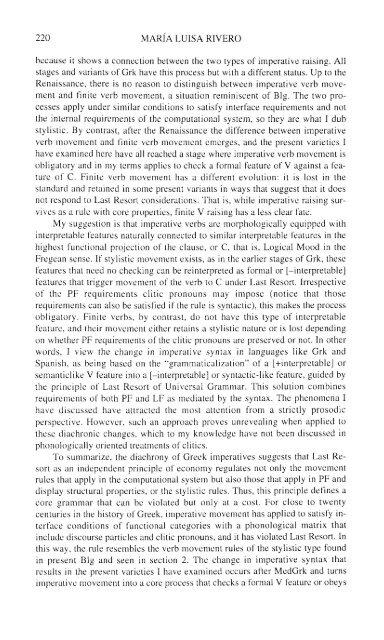Comparative Syntax of the Balkan Languages (Oxford ... - Cryptm.org
Comparative Syntax of the Balkan Languages (Oxford ... - Cryptm.org
Comparative Syntax of the Balkan Languages (Oxford ... - Cryptm.org
- No tags were found...
You also want an ePaper? Increase the reach of your titles
YUMPU automatically turns print PDFs into web optimized ePapers that Google loves.
220 MARIA LUISA RIVERObecause it shows a connection between <strong>the</strong> two types <strong>of</strong> imperative raising. Allstages and variants <strong>of</strong> Grk have this process but with a different status. Up to <strong>the</strong>Renaissance, <strong>the</strong>re is no reason to distinguish between imperative verb movementand finite verb movement, a situation reminiscent <strong>of</strong> Big. The two processesapply under similar conditions to satisfy interface requirements and not<strong>the</strong> internal requirements <strong>of</strong> <strong>the</strong> computational system, so <strong>the</strong>y are what I dubstylistic. By contrast, after <strong>the</strong> Renaissance <strong>the</strong> difference between imperativeverb movement and finite verb movement emerges, and <strong>the</strong> present varieties Ihave examined here have all reached a stage where imperative verb movement isobligatory and in my terms applies to check a formal feature <strong>of</strong> V against a feature<strong>of</strong> C. Finite verb movement has a different evolution: it is lost in <strong>the</strong>standard and retained in some present variants in ways that suggest that it doesnot respond to Last Resort considerations. That is, while imperative raising survivesas a rule with core properties, finite V raising has a less clear fate.My suggestion is that imperative verbs are morphologically equipped withinterpretable features naturally connected to similar interpretable features in <strong>the</strong>highest functional projection <strong>of</strong> <strong>the</strong> clause, or C, that is, Logical Mood in <strong>the</strong>Fregean sense. If stylistic movement exists, as in <strong>the</strong> earlier stages <strong>of</strong> Grk, <strong>the</strong>sefeatures that need no checking can be reinterpreted as formal or [-interpretable]features that trigger movement <strong>of</strong> <strong>the</strong> verb to C under Last Resort. Irrespective<strong>of</strong> <strong>the</strong> PF requirements clitic pronouns may impose (notice that thoserequirements can also be satisfied if <strong>the</strong> rule is syntactic), this makes <strong>the</strong> processobligatory. Finite verbs, by contrast, do not have this type <strong>of</strong> interpretablefeature, and <strong>the</strong>ir movement ei<strong>the</strong>r retains a stylistic nature or is lost dependingon whe<strong>the</strong>r PF requirements <strong>of</strong> <strong>the</strong> clitic pronouns are preserved or not. In o<strong>the</strong>rwords, I view <strong>the</strong> change in imperative syntax in languages like Grk andSpanish, as being based on <strong>the</strong> "grammaticalization" <strong>of</strong> a [+interpretablej orsemanticlike V feature into a [-interpretable] or syntactic-like feature, guided by<strong>the</strong> principle <strong>of</strong> Last Resort <strong>of</strong> Universal Grammar. This solution combinesrequirements <strong>of</strong> both PF and LF as mediated by <strong>the</strong> syntax. The phenomena Ihave discussed have attracted <strong>the</strong> most attention from a strictly prosodicperspective. However, such an approach proves unrevealing when applied to<strong>the</strong>se diachronic changes, which to my knowledge have not been discussed inphonologically oriented treatments <strong>of</strong> clitics.To summarize, <strong>the</strong> diachrony <strong>of</strong> Greek imperatives suggests that Last Resortas an independent principle <strong>of</strong> economy regulates not only <strong>the</strong> movementrules that apply in <strong>the</strong> computational system but also those that apply in PF anddisplay structural properties, or <strong>the</strong> stylistic rules. Thus, this principle defines acore grammar that can be violated but only at a cost. For close to twentycenturies in <strong>the</strong> history <strong>of</strong> Greek, imperative movement has applied to satisfy interfaceconditions <strong>of</strong> functional categories with a phonological matrix thatinclude discourse particles and clitic pronouns, and it has violated Last Resort. Inthis way, <strong>the</strong> rule resembles <strong>the</strong> verb movement rules <strong>of</strong> <strong>the</strong> stylistic type foundin present Blg and seen in section 2. The change in imperative syntax thatresults in <strong>the</strong> present varieties I have examined occurs after MedGrk and turnsimperative movement into a core process that checks a formal V feature or obeys
















